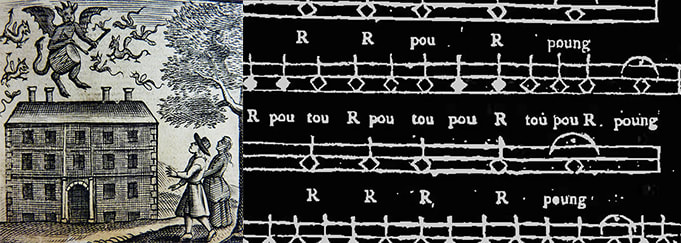The Conversion of St Paul
2012
Detail from Hans Baldung-Grien
The Conversion of St Paul (c.1515)
woodcut
The image has been divided into equal parts, numbered 1 to 12, and their sequence reordered by swapping the position of alternate integers:
3 1 4 2 7 5 8 6 11 9 12 10
Description
The compositions are based upon a recording of bell ringing at St Paul’s Cathedral, London, made while standing at the north side of building and facing west. The sound, produced by a ringing method called the Cambridge Surprise Maximus, is heard to reflect off the façade of Chapter House, opposite, and thereby produce a natural reverberation, delay, and doubling of the audio image. Four 3-second samples were extracted from the recording, of which two are used as the basis for the compositions here. Thus, an individual sample preserves only a portion of the sequence of tuned bells.
The samples are divided into twelve consecutive sections (corresponding to the number of bells used to perform the ring), each 250ms long. These sections are reordered, digitally, following arithmetical systems of permutation derived from the principles of method ringing. In method ringing (which is a form of change ringing) each bell is given a number (1–12 in the case of the bells at the Cathedral). The sequence is permuted by swapping the position of two bells. For example, below: in the first permutation (line two), bell 2 sounds first and bell 1, second). In the second permutation (line three), bell 1 exchanges place with bell 3 and is played third. Over the course of eleven changes, bell 1 will move forward from the first to the twelfth position in the sequence:
1 2 3 4 5 6 7 8 9 10 11 12
2 1 3 4 5 6 7 8 9 10 11 12
2 3 1 4 5 6 7 8 9 10 11 12
Twelve bells have 479,001,600 permutations. As the anonymous writer of Tintinnalogia: Or, The Art of Ringing (London, 1671) speculated: ‘And supposing that twelve men should take 12 bells with intent to ring the changes on them, they would be Seventy five Years, with intent to ring the changes on them, they would be Seventy five Years, ten Months, one Week and three Dayes in ringing them, according to the proportion of ringing 720 changes in an hour; reckoning 24 hours to the day, and 365 dayes in the Year.’
Each sample is subjected to a specific permutation. Two 250ms sound sections are swapped (in the manner of the bells). Each sample has as many variants as required to explore all the permutations. (It is equivalent to completing a peal in bell ringing). Each variant is looped (mimicking the repetition of the melody in bell ringing) twelve times. In Sample 2/Permutation 2, the pair of numbers closest to each other, from the centre outward, change in each sequence:
2012
Detail from Hans Baldung-Grien
The Conversion of St Paul (c.1515)
woodcut
The image has been divided into equal parts, numbered 1 to 12, and their sequence reordered by swapping the position of alternate integers:
3 1 4 2 7 5 8 6 11 9 12 10
Description
The compositions are based upon a recording of bell ringing at St Paul’s Cathedral, London, made while standing at the north side of building and facing west. The sound, produced by a ringing method called the Cambridge Surprise Maximus, is heard to reflect off the façade of Chapter House, opposite, and thereby produce a natural reverberation, delay, and doubling of the audio image. Four 3-second samples were extracted from the recording, of which two are used as the basis for the compositions here. Thus, an individual sample preserves only a portion of the sequence of tuned bells.
The samples are divided into twelve consecutive sections (corresponding to the number of bells used to perform the ring), each 250ms long. These sections are reordered, digitally, following arithmetical systems of permutation derived from the principles of method ringing. In method ringing (which is a form of change ringing) each bell is given a number (1–12 in the case of the bells at the Cathedral). The sequence is permuted by swapping the position of two bells. For example, below: in the first permutation (line two), bell 2 sounds first and bell 1, second). In the second permutation (line three), bell 1 exchanges place with bell 3 and is played third. Over the course of eleven changes, bell 1 will move forward from the first to the twelfth position in the sequence:
1 2 3 4 5 6 7 8 9 10 11 12
2 1 3 4 5 6 7 8 9 10 11 12
2 3 1 4 5 6 7 8 9 10 11 12
Twelve bells have 479,001,600 permutations. As the anonymous writer of Tintinnalogia: Or, The Art of Ringing (London, 1671) speculated: ‘And supposing that twelve men should take 12 bells with intent to ring the changes on them, they would be Seventy five Years, with intent to ring the changes on them, they would be Seventy five Years, ten Months, one Week and three Dayes in ringing them, according to the proportion of ringing 720 changes in an hour; reckoning 24 hours to the day, and 365 dayes in the Year.’
Each sample is subjected to a specific permutation. Two 250ms sound sections are swapped (in the manner of the bells). Each sample has as many variants as required to explore all the permutations. (It is equivalent to completing a peal in bell ringing). Each variant is looped (mimicking the repetition of the melody in bell ringing) twelve times. In Sample 2/Permutation 2, the pair of numbers closest to each other, from the centre outward, change in each sequence:
The Conversion of St Paul: Sample 2/Permutation 2, 2012, 04.12
In Sample 3/Permutation 3, the pair of numbers furthest from each other progress to each other’s position throughout the succession of sequences:
The Conversion of St Paul: Sample 3/Permutation 3, 2012, 04.12
In Sample 1/Permutation 1, a pair of alternate numbers change in each sequence:
The Conversion of St Paul: Sample 1/Permutation 1, 2012, 04.12
In Sample 4/Permutation 4, a pair of numbers furthest from each other progress to each other’s position throughout the succession of sequences:
The Conversion of St Paul: Sample 1/Permutation 1, 2012, 07.09
In Christian theology, to convert (Greek: ἐπιστρέφω) is, variously, to change or adapt in form, or turn back, or turn one’s self about – which processes and mutation are precisely what the sequences governing the compositions have undergone.
Personnel: St Paul’s Cathedral Guild of Ringers and John Harvey.
Instrumentation: Adobe Audition 3.0, Apple MacBook Pro OS X 10.8, bells of St Paul’s Cathedral, Sony ECM-DS70P microphone, and Sony MZ-RH10 Hi-MD Walkman Digital Music Player/Recorder.
Source: Sample recorded at St Paul's Cathedral, London, UK, February 20, 2005.
Personnel: St Paul’s Cathedral Guild of Ringers and John Harvey.
Instrumentation: Adobe Audition 3.0, Apple MacBook Pro OS X 10.8, bells of St Paul’s Cathedral, Sony ECM-DS70P microphone, and Sony MZ-RH10 Hi-MD Walkman Digital Music Player/Recorder.
Source: Sample recorded at St Paul's Cathedral, London, UK, February 20, 2005.





